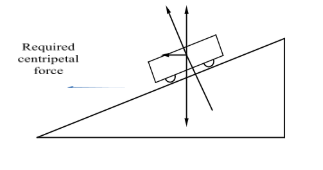
A circular railway track of radius r is banked at angle so that a train moving with speed v can safely go round the track. A student writes: $tan\theta = \dfrac{{rg}}{{{v^2}}}$. Why is this relation not correct?
(i) Equality of dimension does not guarantee correctness of the relation
(ii) Dimension correct relation may not be numerically correct
(iii) The relation is dimensionally incorrect.
A.) (i) and (ii)
B.) (ii) and (iii)
C.) (iii) and (i)
D.) (i), (ii) and (iii)
Answer
588k+ views
Hint: In dimensional analysis, the presence or absence of constants, ratios, trigonometric identities cannot be determined. They are dimensionless. That means the dimension is ${M^0}{L^0}{T^0}$. Therefore adding or removing them does not affect the equation.
Formula used: Centripetal Force : \[{F_c} = \dfrac{{m{v^2}}}{r}\] \[\]
Complete step by step solution:
The car moving on a normal road does not experience any forces other than its weight, normal reaction and friction. In this question the frictional force is not considered.
So we have its weight $mg$ acting downwards and its normal reaction $N$ acting upwards.

Car on a banked road with no friction
Here we can see that due to banking of the road the normal reaction is not straight up.
It is normal to the banked road which makes an angle of $\theta $ with the horizontal surface.
Taking components of the normal reaction in parallel and perpendicular directions with respect to horizontal surface, we can come to these conclusions that (see fig 2)
(i) The $\cos \theta $ component of N(normal reaction) balances the weight of the car.
(ii) The $\sin \theta $ component of N(normal reaction) provides the necessary centripetal force for the car.
$Ncos\theta = mg$
$N = \dfrac{{m \times g}}{{cos\theta }}$
Similarly
$Nsin\theta = \dfrac{{m \times {v^2}}}{r}$
${F_{centripetal}} = \dfrac{{m \times {v^2}}}{r}$ (And this is balanced by $Nsin\theta $)
Substituting value of $N$, we get
$\dfrac{{m \times {v^2}}}{r} = \left( {\dfrac{{m \times g}}{{cos\theta }}} \right) \times sin\theta = mgtan\theta $
$mgtan\theta = \dfrac{{m \times {v^2}}}{r}$
Rearranging, $tan\theta = \dfrac{{{v^2}}}{{rg}}$
This shows that even though the equation is dimensionally correct, the answer is wrong.
Therefore (i) and (ii) are the correct options
Note: Unlike other inclined plane problems we took the components of normal in horizontal and vertical direction since the acceleration is along these directions. Usually in inclined problems the components of mass $mg$ are taken parallel and perpendicular to the inclined plane.But here taking components of the normal force in the horizontal and vertical direction makes it simpler to understand.
Formula used: Centripetal Force : \[{F_c} = \dfrac{{m{v^2}}}{r}\] \[\]
Complete step by step solution:
The car moving on a normal road does not experience any forces other than its weight, normal reaction and friction. In this question the frictional force is not considered.
So we have its weight $mg$ acting downwards and its normal reaction $N$ acting upwards.

Car on a banked road with no friction
Here we can see that due to banking of the road the normal reaction is not straight up.
It is normal to the banked road which makes an angle of $\theta $ with the horizontal surface.
Taking components of the normal reaction in parallel and perpendicular directions with respect to horizontal surface, we can come to these conclusions that (see fig 2)
(i) The $\cos \theta $ component of N(normal reaction) balances the weight of the car.
(ii) The $\sin \theta $ component of N(normal reaction) provides the necessary centripetal force for the car.
$Ncos\theta = mg$
$N = \dfrac{{m \times g}}{{cos\theta }}$
Similarly
$Nsin\theta = \dfrac{{m \times {v^2}}}{r}$
${F_{centripetal}} = \dfrac{{m \times {v^2}}}{r}$ (And this is balanced by $Nsin\theta $)
Substituting value of $N$, we get
$\dfrac{{m \times {v^2}}}{r} = \left( {\dfrac{{m \times g}}{{cos\theta }}} \right) \times sin\theta = mgtan\theta $
$mgtan\theta = \dfrac{{m \times {v^2}}}{r}$
Rearranging, $tan\theta = \dfrac{{{v^2}}}{{rg}}$
This shows that even though the equation is dimensionally correct, the answer is wrong.
Therefore (i) and (ii) are the correct options
Note: Unlike other inclined plane problems we took the components of normal in horizontal and vertical direction since the acceleration is along these directions. Usually in inclined problems the components of mass $mg$ are taken parallel and perpendicular to the inclined plane.But here taking components of the normal force in the horizontal and vertical direction makes it simpler to understand.
Recently Updated Pages
Why are manures considered better than fertilizers class 11 biology CBSE

Find the coordinates of the midpoint of the line segment class 11 maths CBSE

Distinguish between static friction limiting friction class 11 physics CBSE

The Chairman of the constituent Assembly was A Jawaharlal class 11 social science CBSE

The first National Commission on Labour NCL submitted class 11 social science CBSE

Number of all subshell of n + l 7 is A 4 B 5 C 6 D class 11 chemistry CBSE

Trending doubts
What is meant by exothermic and endothermic reactions class 11 chemistry CBSE

10 examples of friction in our daily life

One Metric ton is equal to kg A 10000 B 1000 C 100 class 11 physics CBSE

1 Quintal is equal to a 110 kg b 10 kg c 100kg d 1000 class 11 physics CBSE

Difference Between Prokaryotic Cells and Eukaryotic Cells

What are Quantum numbers Explain the quantum number class 11 chemistry CBSE




